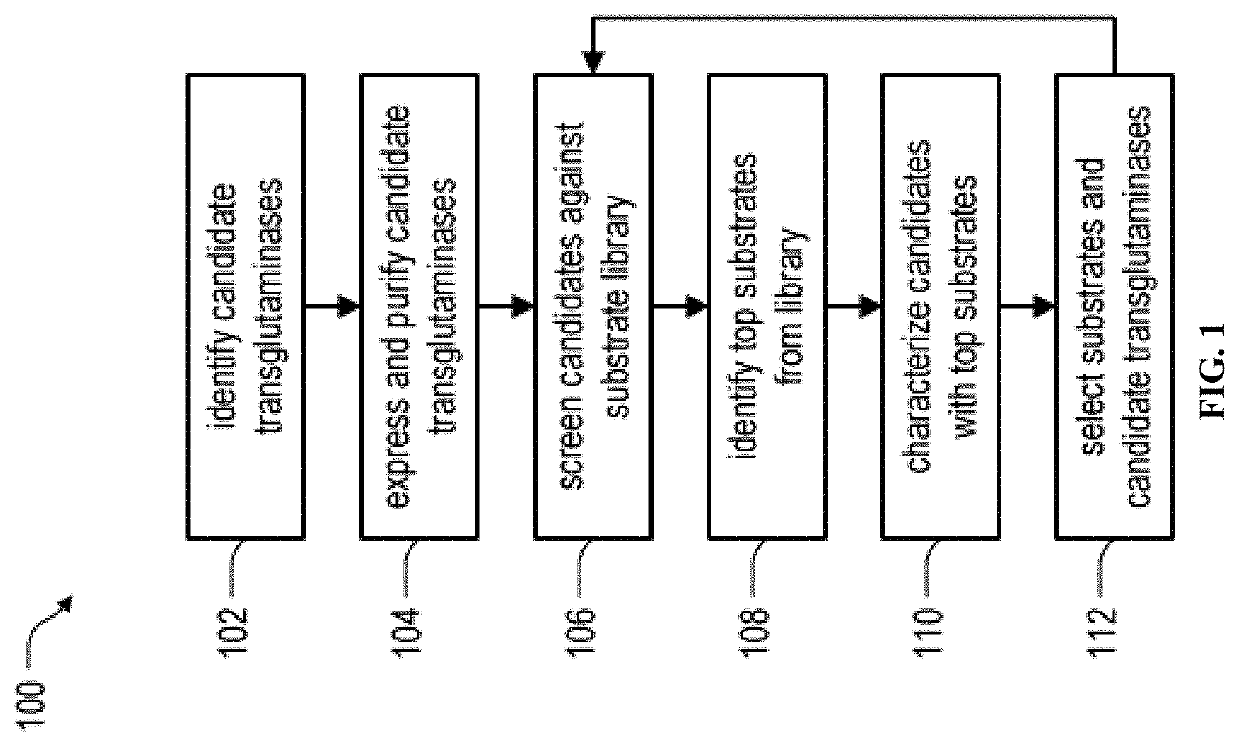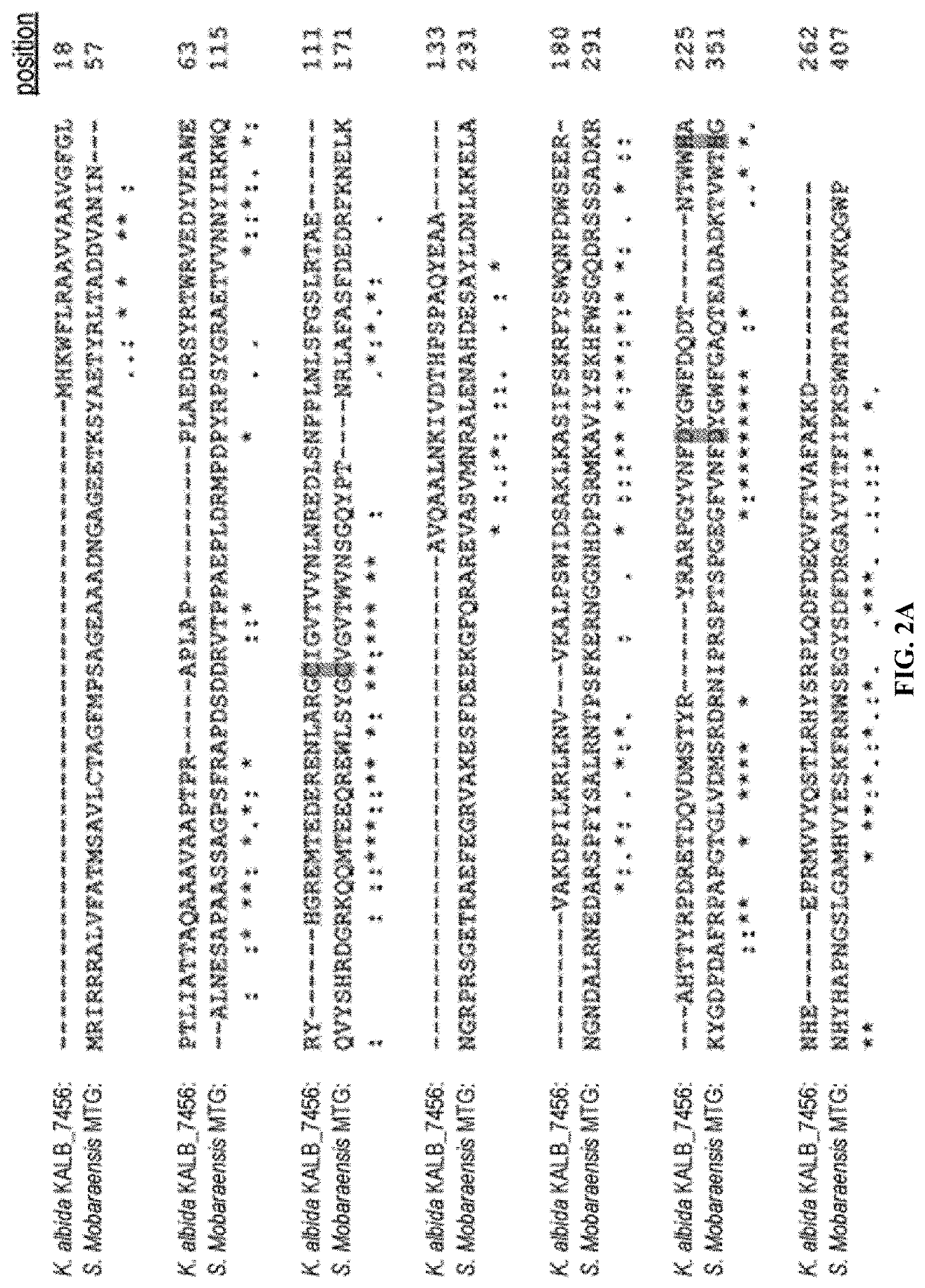System and method for identification and characterization of transglutaminase species
a transglutaminase and identification system technology, applied in the field of identification and characterization of microbial transglutaminases, can solve the problems of inconvenient identification and characterization of known and novel transglutaminases, inconvenient identification of transglutaminases, and inability to identify and characterization transglutaminases with the same or similar substrate specificity,
- Summary
- Abstract
- Description
- Claims
- Application Information
AI Technical Summary
Benefits of technology
Problems solved by technology
Method used
Image
Examples
example 1
Identification of the K. albida Microbial Transglutaminase
[0094]Establishing a viable and robust, enzymatic, industrial-scale method for site-specific conjugation approaches like antibody-drug conjugates makes high demands on the coupling enzyme. Among other factors, it may be useful for such approaches to have a high reaction rate, conjugation efficacy, and substrate specificity. Further, it may be useful for such approaches to be economical in production, include an enzyme having a low molecular weight, an enzyme that is independent of cofactors, the like, and combinations thereof. For discovery of new microbial transglutaminases, a search for homologs of this enzyme that may fulfill all the mentioned criteria was performed using the amino acid sequence of S. mobaraensis protein-glutamine gamma-glutamyltransferase as a query. This yielded the hypothetical gene product KALB_7456 from bacteria K. albida DSM 43870, a spore-forming gram-positive bacterium which was sequenced in 2014 (...
example 2
Parallel Construct Evaluation for Recombinant Production of KalbTG
[0099]To rapidly screen expression conditions for the hypothetical K. albida transglutaminase (KalbTG), we inserted the synthetic genetic insert into multiple expression vectors designed for the soluble cytosolic or periplasmic expression in E. coli using a fragment exchange system (Geertsma, et al. 2011. Biochemistry 50(15): 3272-3278).
[0100]Initial screening at the 5 ml scale provided clear evidence that proteins with the anticipated electrophoretic mobility of full length KalbTG fusions were expressed, and that a fusion with tandem SlyD chaperones (Scholz, et al. 2005. Journal of Molecular Biology 345(5): 1229-1241) yielded the highest amount of soluble protein among all the constructs tested (FIG. 3A). The expression of this construct was further optimized by screening different incubation times and temperatures, Isopropyl β-D-1-thiogalactopyranoside (IPTG) inducer concentrations and induction times, media types a...
example 3
Use of Peptide Arrays for Transglutaminase Substrate Discovery
[0116]To identify potential acyl-donor and amine-donor substrates of the K. albida transglutaminase, high-throughput screening on 5-mer peptide arrays was performed (FIGS. 4A and 4B). An activity of at least 1.65 U / mg for both the SlyD-fused and the mature KalbTG enzymes was confirmed by commercial assay (Zedira MTG-ANiTA-KIT; compared to 4.3 U mg−1 by the MTG supplied with the kit and a 0.07 U / mg blank value with BSA). The assay used β-casein as a cross-linking substrate and detected deamidation by a glutamate dehydrogenase dependent oxidation of NADPH. Specific recognition motifs were identified by assaying KalbTG with peptide arrays prepared by maskless array synthesis (U.S. Pat. Pub. No 2015 / 0185216 to Albert et al. filed on 19 Dec. 2014). The efficiency of the transamidation reaction between 1.4 million unique 5-mer peptides and a biotinylated amine donor was quantified on two arrays in parallel and the sequences of ...
PUM
| Property | Measurement | Unit |
|---|---|---|
| Fraction | aaaaa | aaaaa |
| Molar density | aaaaa | aaaaa |
| Mass | aaaaa | aaaaa |
Abstract
Description
Claims
Application Information
 Login to View More
Login to View More - R&D
- Intellectual Property
- Life Sciences
- Materials
- Tech Scout
- Unparalleled Data Quality
- Higher Quality Content
- 60% Fewer Hallucinations
Browse by: Latest US Patents, China's latest patents, Technical Efficacy Thesaurus, Application Domain, Technology Topic, Popular Technical Reports.
© 2025 PatSnap. All rights reserved.Legal|Privacy policy|Modern Slavery Act Transparency Statement|Sitemap|About US| Contact US: help@patsnap.com



